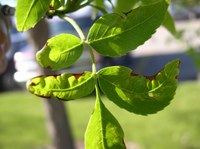Anthracnose Hitting Ash Trees Hard
(Click the image below to view a high-resolution image that can be downloaded)
Many people have noticed leaves falling from their ash trees and are worried the trees are dying.
They can stop worrying, according to Joe Zeleznik, North Dakota State University Extension forestry specialist.
“The leaves are falling due to a fungal problem called ash anthracnose,” Zeleznik says. “Ash anthracnose occurs during wet springs, and this year it’s especially problematic through much of southern North Dakota.”
The cool, wet conditions that followed initial leaf-out provided the fungus with near-perfect growing conditions. With the rapid leaf growth that followed the recent warm temperatures, the fungal population exploded, and many ash trees began losing their leaves.
Leaf loss may continue for a couple of weeks until drier conditions prevail or developing leaf tissue hardens off for the summer. Leaves that don’t fall off may grow into curled shapes as the leaf margins turn black and die while the remainder of the leaf tissue grows normally.
“At this point, fungicide treatments are likely not warranted,” Zeleznik says. “Fungicides for ash anthracnose should be applied only before the disease hits, and we’ve missed that window of opportunity.”
The amount of leaf loss can be worrisome to some people, but it is not considered “major” until 25 percent or more of the leaves are gone. At that point, a tree can begin to get stressed. Trees that lose this quantity of leaves for three or more consecutive years are the most susceptible to decline.
“But because this is the first time since 2015 we’ve had much ash anthracnose, the likelihood of major stress on ash trees is pretty low,” Zeleznik says.
About the only action you can take now is to help defoliated trees grow new leaves by giving the trees a light application of nitrogen fertilizer at the rate of 1 to 2 pounds per 1,000 square feet, he says.
In the fall, raking and destroying fallen leaves also will help minimize next year’s disease pressure because the fungus overwinters in dead leaf tissue, among other substances.
“Mostly, though, it’s simply a matter of waiting out the disease and allowing nature to take its course,” Zeleznik says.
NDSU Agriculture Communication - June 7, 2019
| Source: | Joe Zeleznik, 701-231-8143, joseph.zeleznik@ndsu.edu |
|---|---|
| Editor: | Ellen Crawford, 701-231-5391, ellen.crawford@ndsu.edu |


